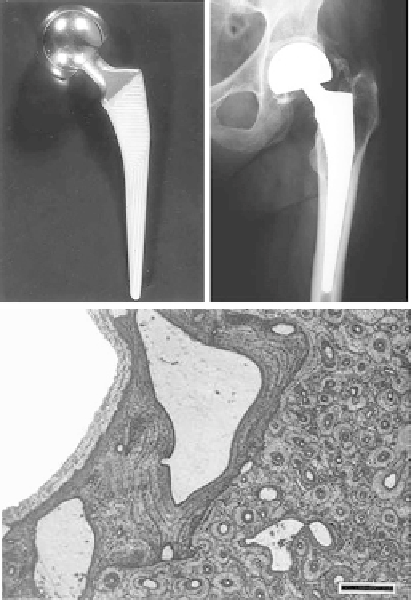Biomedical Engineering Reference
In-Depth Information
(a)
(b)
i
ha
tb
tb
(c)
FIGURE 4.1
HA-coated Ti6Al4V femoral implant. (a) Morphology before implantation, and (b) radiograph of the implant 3
years after implantation. Formation of trabecular bone (tb) in the periprosthetic gap and in continuity with the
host bone. HA coating appears unabsorbed. (i): metallic implant. Scale bar: 500 µm. (From Hardy, et al.,
Eur. J.
Orthop. Surg. Traumatol.
, 9, 75-81, 1999. With permission.)
that HA has in biomedical applications, it is very important to investigate the production
methods and the properties/processing parameters. Many methods have been used for
the production of HA powders and coatings on different substrates, among which ther-
mal spray is the most promising technique for depositing HA coatings with controllable
microstructure and properties. To date, the potential medical applications of the HA-coated
prosthesis have been investigated. However, in order to achieve those goals, it is essential
to optimize production methods for and clarify property/process relationships of the HA
coatings. To achieve the properties required by the service circumstance, many manufac-
turing methods for HA coating preparation have been attempted. In recent years, research
on nanobiomaterials has been booming and improved performances have been widely
reported, even though synthesis/fabrication of nanobiomaterials in an economic and reli-
able manner remains challenging. Nevertheless, it seemed clear that surface modification
of biomaterials (e.g., nanostructuring) gives rise to enhanced biocompatibility of the bio-
materials. The presence of nanostructures within the coatings and at the coating/substrate
interface might also enhance the properties of the coatings. Thermal sprayed HA coatings
might, through optimized experiment design, be able to provide favorable surface patterns
apart from the phases that favor cell attachment and proliferation.
A good prosthetic design should accommodate eventualities such as coating failure
without jeopardizing the function of the implant. This perception is important to ensure

Search WWH ::

Custom Search